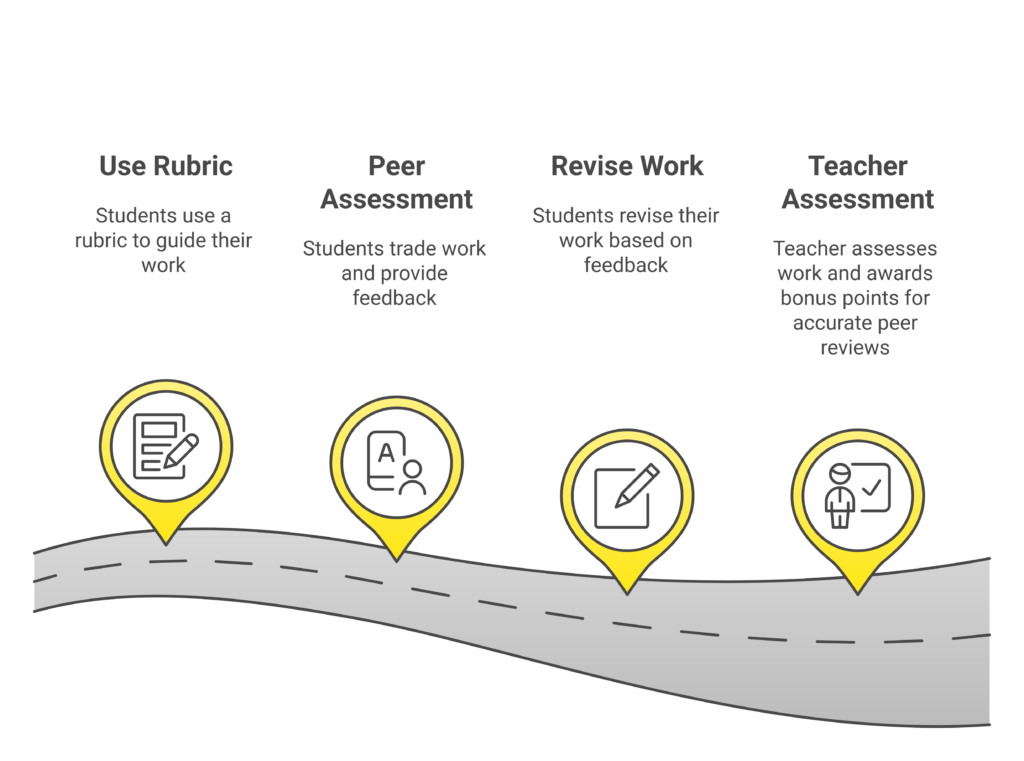Lately, I’ve been reading a lot of posts from teachers on Reddit sharing how grading has taken over their lives. I remember the days… They talk about spending evenings and weekends drowning in piles of assignments, leaving little time for lesson planning, family, or — let’s be honest — basic sanity. And honestly, I get it. When I was in the classroom, grading felt like an endless cycle. Just when I thought I was caught up, another stack of work would need attention so grades could be reported in a timely fashion. But what if grading didn’t have to be such a time-consuming, energy-draining task? What if we could shift some of the responsibility, save time, and engage students in a way that actually helps them learn better?
That’s where this 4-step grading process comes in. It’s a simple approach that takes some of the burden off teachers while engaging students in the grading process so they aren’t just passive recipients of a score. Here’s how it works:
- Students use a rubric to guide their work. They understand expectations before they even start.
- A peer evaluates their work using the rubric and provides specific, structured feedback.
- Students reflect on the feedback and revise before submitting their final version. This step is critical and often not included in the assessment process.
- The teacher assesses the final work, and if the peer assessment was accurate, that student earns a bonus point.
This method does three key things:
- Saves time by ensuring students turn in better-quality work before you even see it.
- Engages students in their own learning by making them active participants in the grading process.
- Teaches valuable evaluation skills that improve their ability to self-assess and learn from feedback.
Instead of carrying the grading load alone, this process turns assessment into a meaningful learning experience. It’s grading smarter, not harder.

The Problem with Traditional Grading
Unless you are grading scantrons or multiple choice worksheets, grading isn’t just time-consuming—it’s exhausting. Teachers spend hours marking assignments, only to feel like they barely made a dent. It’s a never-ending cycle, and the more detailed the feedback, the longer it takes. I’ve seen countless Reddit threads where teachers talk about grading burnout, and I lived it myself when I was in the classroom.
But time isn’t the only issue. Traditional grading has three major flaws that make it inefficient and ineffective when trying to save time and engage students:
1. It puts all the responsibility on the teacher.
- In most classrooms, grading is something teachers do to students rather than with them.
- Students complete an assignment, turn it in, and wait for a grade without being involved in evaluating their own work.
- This creates a one-way process where students miss opportunities to reflect and improve before getting their final score.
2. Students don’t engage with feedback.
- How many times have you carefully written comments on a student’s paper, only to have them glance at the grade and toss it aside?
- Once an assignment is graded, most students move on instead of using feedback to improve.
- This means teachers are spending time giving feedback that often goes unread.
3. Grading is often disconnected from learning.
- When students see grades as an endpoint rather than part of the learning process, they don’t develop strong self-evaluation skills.
- If they struggle with an assignment, they may assume they just aren’t “good” at the subject rather than recognizing areas for growth.
- This creates a cycle where students rely on teachers for all evaluation instead of learning to assess their own work.
These issues make grading a burden for teachers and a missed opportunity for students. That’s why we need a better approach to save time and engage students. One that keeps grading fair and accurate while also making it more efficient and meaningful.
The 4-Step Grading Process to Save Time and Engage Students
Instead of carrying the full weight of grading alone, this process shifts part of the responsibility to students—while keeping grading fair, accurate, and meaningful.
Step 1: Students Use a Rubric to Guide Their Work
- Provide the rubric upfront so students know expectations before they begin.
- Model how to use it by assessing a sample assignment together.
- Encourage self-checking before submission, so students catch mistakes early.
Step 2: Peer Assessment and Feedback
- Students trade work and use the rubric to evaluate a peer’s assignment.
- Require specific feedback based on rubric criteria—no vague comments like “good job” or “needs work.”
- Provide sentence stems to guide structured feedback (e.g., “One area for improvement is __ because __.”).
Step 3: Students Revise Based on Feedback
- Give time for reflection and revision after receiving peer feedback.
- Require a revision statement, so students justify their changes.
- Hold students accountable for either making improvements or explaining why they didn’t.
Step 4: Teacher Assessment with a Bonus for Accurate Peer Reviews
- If a peer’s assessment closely matches the teacher’s, that student earns a bonus point.
- Encourages careful grading, since inaccurate assessments don’t earn the bonus.
Final Thoughts
This 4-step process isn’t just about grading—it’s about changing how students engage with assessment.
- Teachers spend less time grading unfinished work.
- Students take ownership of their learning.
- Feedback is used, not ignored.
Try It for Yourself
✅ Start with one assignment to test the process.
✅ Use peer grading practice rounds before jumping into major projects.
✅ See if students submit stronger work after revision.
I’d love to hear your thoughts! Have you tried peer assessment in your classroom as a way to save time and engage students? What strategies have helped you save time on grading? Drop a comment and let’s keep the conversation going!

